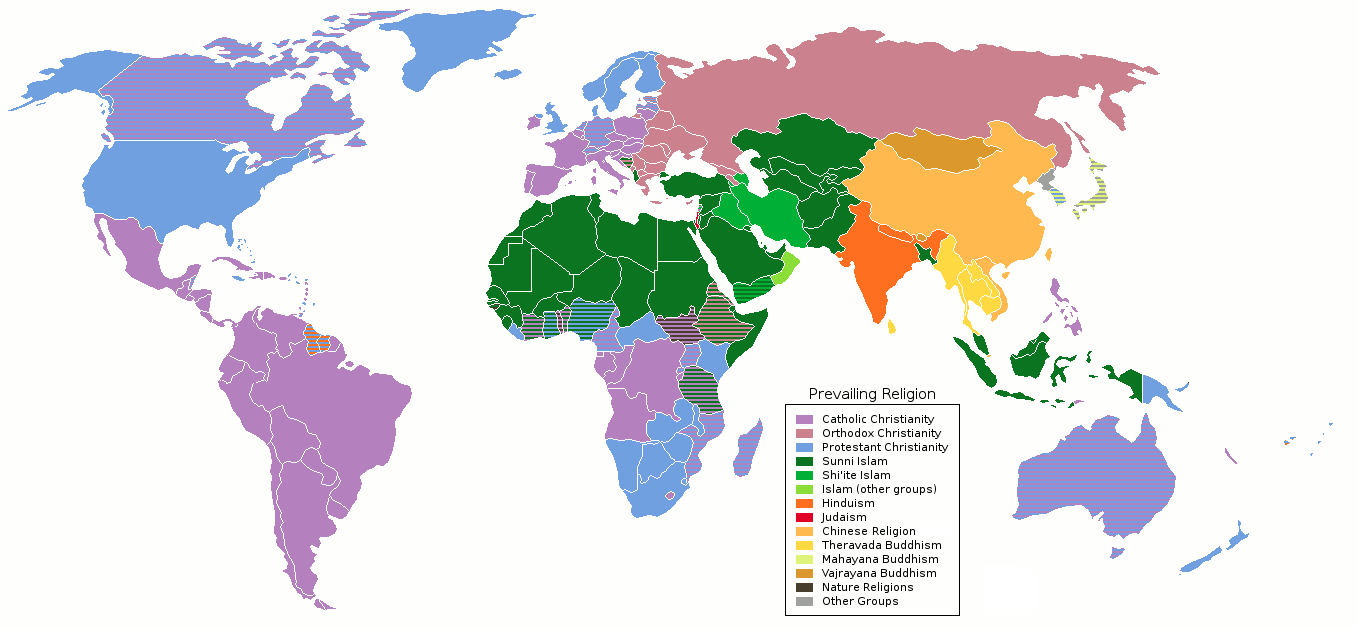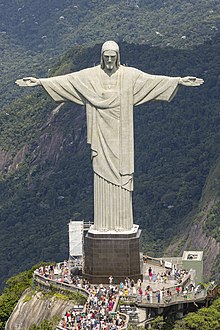Chapter 8: The Geography of Religion
8.4.1 Christianity
The Religion
Christianity is a universalizing, monotheistic religion centered on the life and teachings of Jesus of Nazareth. It dates to the first century AD since the Western world uses the Christian calendar. Christianity began as an offshoot of Judaism and includes the Hebrew Bible (known to Christians as the Old Testament) as well as the New Testament, which contains the teachings of Jesus, as its canonized scriptures. The Christian canon centers on the belief that Jesus of Nazareth was the human-born son of God. Christians believe Jesus was born to a virgin and spent his life teaching and performing miracles such as healing the sick and raising the dead. Tradition has Jesus being crucified by the Romans and raised from the dead three days later. Christians believe in life after death and the forgiveness of sins.
Christianity has three main branches: Roman Catholic, Orthodox, and Protestant . Catholic and Orthodox Christianity split roughly one thousand years ago, while the Protestant/Catholic split began in the 16th century. The three branches of Christianity occupy different spaces, with a great deal of overlap between them. Orthodox Christianity is mostly seen in Russia, Eastern Europe, and Southern Europe; also in Africa – Egypt, Ethiopia – and in places where large numbers of people from these places have migrated to i.e. the United States, Canada.
Please have a look at the map provided by the Visual Capitalist web site displaying the Global Distribution of Christianity.
Diffusion
Christianity was founded in the eastern Mediterranean, although much like Buddhism, its greatest successes were found in other parts of the world (see map below Figure 8.4.1.1). Christianity initially grew in areas dominated by the Roman Empire, but it would adapt and thrive in many places. With the collapse of the Empire, Christianity became the only source of social cohesion in Europe for centuries. Later, Christianity was promoted through the process of colonialism, and as such, it was modified by the process that distributed it. The spread of Christianity helped drive the process that created the modern world.

Source: “Figure 6.13 Diffusion by Christianity” in “Introduction to Human Geography” by David Dorrell via LOUIS Pressbooks is licensed under CC BY-SA 4.0.
Catholic Christianity is seen in a wider range of places as can be seen on the map below. It largely formed around the historic Roman Empire, then spread to the north and west of Europe. Catholicism did not stop there, however. The age of colonial expansion transplanted Catholicism to such widespread places as the Philippines, much of the Americas and Caribbean, and large parts of Africa. Protestantism is the most recently developed Christian branch, but it has also diffused widely. The initial Protestant countries were in northern Europe, but again due to colonialism, Protestant Christianity was exported to places like the United States, South Africa, Ghana, Australia, and New Zealand. The current expansion of Christianity, particularly in Asia, is largely due to the growth of Protestantism. The following, Figure 8.4.1.2, map shows the global diffusion of the three Christian branches clearly.

Source: “Prevailing world religions map” by LilTeK21 at English Wikipedia (original author) via Wikimedia Commons is licensed under CC BY-SA 3.0.
Appearance in the Landscape

Source: Photo by Barbara Crain, CC BY 4.0.
Each Christian branch has developed a distinct appearance in the landscape. Orthodox churches are meant to invoke a sense of the divine. Buildings are elaborate, both inside and outside.

Source: Photo by Barbara Crain, CC BY 4.0.
Catholic churches also tend to be elaborate, in a similar vein to Orthodox churches, but with a different architectural tradition. This is understandable; these two branches of Christianity arose in different places with different ideas of architectural grandeur and beauty.

Source: Photo by Barbara Crain, CC BY 4.0.
In general, the architecture of churches and temples often reflects the desire of religious people to honor their God(s). Worshippers strive to create monuments that embody the essence of their faith. Catholic churches, for instance, are often grand and monumental because many Catholics consider them to be the “House of God.” Inspiring architecture can help individuals feel the presence of the divine and motivate them to adhere to religious teachings. Additionally, architecture can serve an educational purpose. This was particularly important when literacy rates were low, with magnificent stained-glass windows in many churches depicting stories from the Bible. Moreover, architecture can also be a tool for attracting new converts.

Source: Photo by Barbara Crain, CC BY 4.0.
Protestant churches as a collective are less elaborate than their close relatives. This is a reflection of the early history of Protestant churches, which were often specific rejections of the elaborate ceremony and display of the Catholic Church.

Source: Photo by Barbara Crain, CC BY 4.0.
Elaborate church buildings are often criticized by those who believe that Christian doctrine calls for humility before the Lord in all aspects of life. In the U.S., the Amish and certain orders of the Mennonites best embody this belief. Some conservative Amish groups do not construct church buildings at all, preferring to gather for worship in private homes, emphasizing the biblical passage that states God “does not dwell in temples made with hands”.

Some statues have become iconic as the one shown here from Rio de Janeiro which overlooks much of the city.
The statue of Christ the Redeemer in Rio de Janeiro is one of the most iconic landmarks in the world. Standing 98 feet tall atop the Corcovado Mountain, with arms outstretched 92 feet wide, it overlooks the city and symbolizes peace, openness, and the embracing nature of Christianity. Unveiled in 1931, this Art Deco statue has become a global symbol of Brazil, recognized for its striking presence and the breathtaking panoramic views it offers of Rio. Its status as a cultural and religious icon has made it one of the New Seven Wonders of the World, drawing millions of visitors annually.

Source: Photo by Barbara Crain, CC BY 4.0.
In areas where Catholicism is prevalent, small folk-art shrines, generally dedicated to the Virgin Mary and enclosed in an artificial grotto, are easily spotted.

